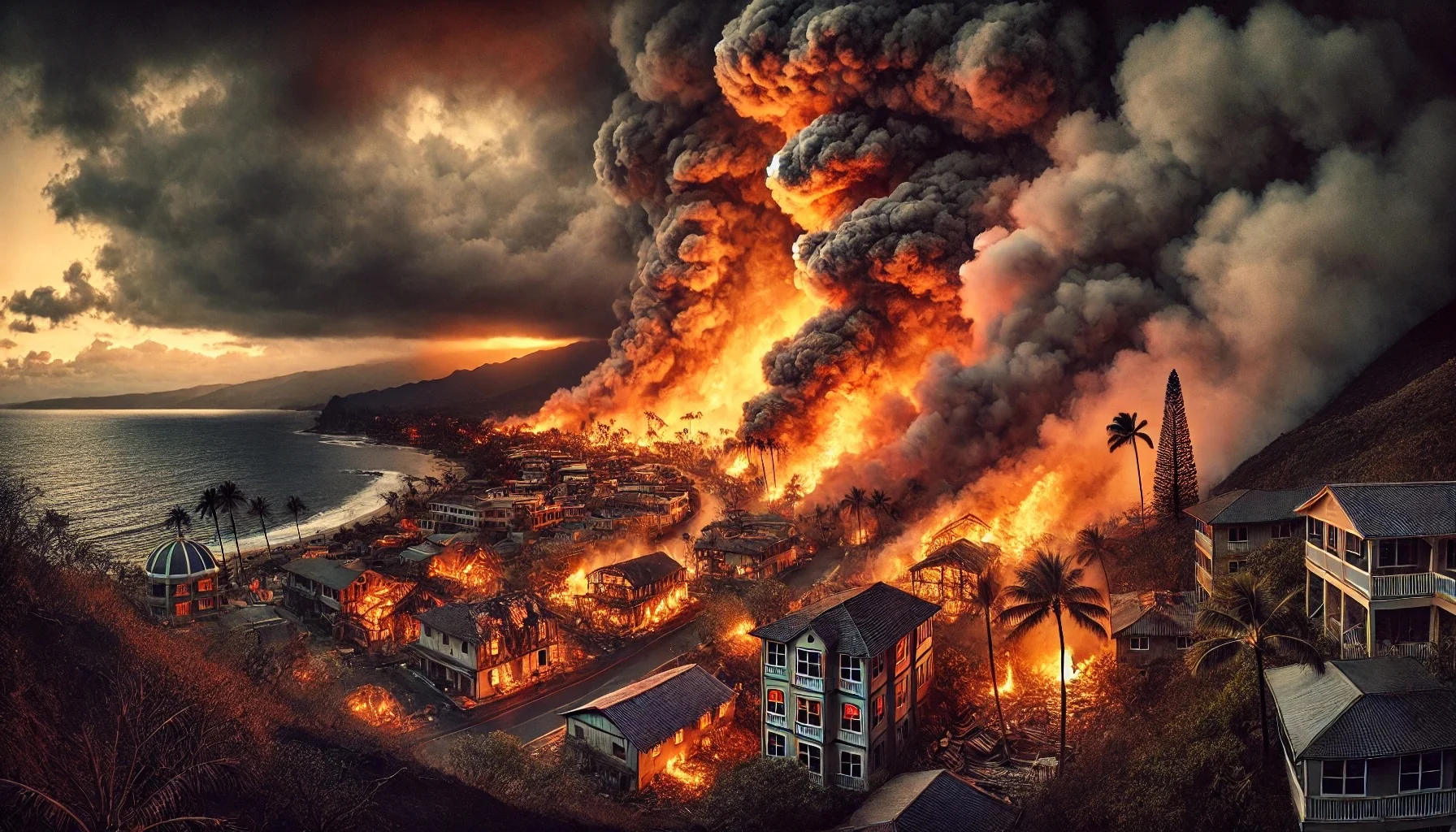
The 2023 Hawaii Wildfires
by: The Calamity Calendar Team
August 8, 2023
The Spark of a Catastrophe
On August 8, 2023, a disaster unfolded on the Hawaiian island of Maui that would become one of the deadliest wildfires in United States history. The conditions leading up to this event were a perfect storm: Maui had been enduring an intense drought, leaving the landscape parched and the vegetation highly flammable. This dryness, coupled with the fierce winds generated by Hurricane Dora passing hundreds of miles to the south, set the stage for a rapid and uncontrolled spread of fire.
Maui, a beloved tourist destination known for its stunning beaches and lush landscapes, also boasts a rich cultural history, particularly in the town of Lahaina. Once the capital of the Hawaiian Kingdom, Lahaina is a vibrant hub of historical and cultural significance, with a population that blends local residents with visitors from around the world. As the fires ignited, this area became the epicenter of the disaster.
Flames Sweep Across Maui
The morning of August 8 began with ominous reports of wildfires breaking out in multiple locations across Maui. As the day progressed, the situation rapidly deteriorated. The strong winds, gusting up to 60 miles per hour, transformed the fires into a deadly force, pushing flames through Lahaina and surrounding areas with alarming speed.
By afternoon, emergency alerts were issued across the island, warning residents and tourists of the impending danger. In Lahaina, the situation was dire. Evacuation orders were given, but the speed of the fires caught many by surprise. As evening fell, the once bustling town was engulfed in flames. The fires consumed hundreds of structures, including homes, businesses, and cherished historic sites, reducing much of Lahaina to ashes. Emergency services battled valiantly against the flames, but the combination of high winds and rugged terrain made containment nearly impossible.
Thanks for subscribing!
A Community in Crisis
In the days that followed, from August 9 to 11, firefighting efforts continued relentlessly. Teams from across Hawaii and the mainland United States joined local responders in an attempt to control the blazes. Despite their tireless work, the fires spread over 2,000 acres, fueled by the relentless winds and dry conditions.
Thousands of residents and visitors were forced to flee their homes, seeking refuge in emergency shelters hastily set up across the island. The community of Maui, known for its close-knit spirit, rallied together, providing support and comfort to those who had lost everything.
The Aftermath and Response
By August 12, there was a glimmer of hope as winds began to subside, allowing firefighters to make progress in containing the fires. By August 15, significant strides had been made, and containment efforts began to turn the tide. However, the damage was already done. Initial assessments revealed widespread devastation in Lahaina and beyond. Over 2,200 structures were destroyed, including irreplaceable cultural landmarks, and the financial cost of the damage soared to over $5.5 billion.
Tragically, the human toll was even more severe. At least 97 people lost their lives, with hundreds more injured. Many remained unaccounted for in the immediate aftermath, compounding the community’s grief. The wildfires of August 2023 thus became one of the most lethal in the nation’s history.
Moving Forward
In response to the catastrophe, a massive effort to aid the affected communities was launched. Local emergency services were bolstered by federal assistance following President Joe Biden’s declaration of a major disaster. This declaration unlocked crucial resources and funds to support recovery and rebuilding efforts.
Long-term recovery plans focused on reconstructing Lahaina and other devastated areas with an emphasis on resilience and sustainability. The goal was to create fire-resistant structures and improve emergency preparedness to mitigate future risks.
The disaster also sparked crucial conversations about the role of climate change in the increasing frequency and intensity of such natural disasters. The fires highlighted the urgent need for adaptive measures and strategies to address the growing threat of wildfires in Hawaii and beyond.
Looking for Answers
As recovery efforts continue, investigations are underway to determine the precise cause of the wildfires. Early reports suggest that downed power lines, toppled by the high winds, may have ignited the fires, but conclusive findings are still pending.
This tragedy underscores the importance of preparedness and adaptation in the face of a changing climate. As the people of Maui rebuild their lives, the lessons learned from the August 2023 wildfires will shape a more resilient and united community, determined to protect their island home from future threats.
Stay in the Loop!
Become a Calamity Insider and get exclusive Calamity Calendar updates delivered straight to your inbox.
Thanks! You're now subscribed.